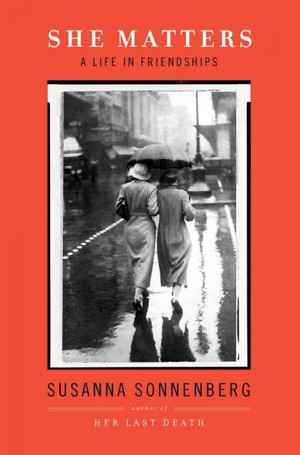Books |
She Matters: A Life in Friendships
Susanna Sonnenberg
By
Published: Mar 24, 2013
Category:
Memoir
It used to bug me how, at a certain point at parties, half a dozen of the most interesting women would get up and stroll to the ladies room.
Their reason, I came to understand, was neither cosmetic nor functional — they just knew a better party was to be had sitting on the edge of the bathtub, chatting among themselves.
One night I did what I’d wanted to do for years: I followed them.
An exception was made and — be still my heart — I was treated like “one of the girls.” And I understood why they fled the living room: A better time really was to be had without men. That is: greater intimacy, sharper sharing, edgier stories.
That is also true of Susanna Sonnenberg’s “She Matters: A Life in Friendships.” I’d read her first memoir — Her Last Death — and greatly admired her account of a childhood spent with a drug-soaked, sex-addicted, wildly destructive mother and an eccentric, distracted father. Sonnenberg’s story was compelling, but what really impressed me was the writing. By now pretty much anyone can serve up a lurid tale; Sonnenberg not only faced the truth about her family’s pathology, she crafted it with style, wit, and, remarkably, distance.
“She Matters” tells twenty stories: Sonnenberg’s intense friendships with twenty women. That number alone is impressive — I don’t think I’ve had twenty friends in my life. And I don’t know anyone who would say that friends are as crucial to life as oxygen.
But here is Patricia, “who marked what mattered between friends…you witness and love, and you feel loved. She wasn’t asking for anything.” And here, at summer camp, is Jessica. “On the last day we said, ‘How can I live without you?’” Here, in boarding school, is an easier but narrow friendship: Abigail’s biggest concerns are sports and grades. She’s followed by Claudia, another child from a moneyed family, who falls for a back-to-the-land fantasy. Esther, the college roommate, is a kind of twin: “two Jewish girls from peace and privilege with good educations.” Junior year abroad brings a Sapphic moment with Miriam. Annabelle lived upstairs with her husband; when Susanna announced she too was getting married, Annabelle bluntly told her that her fiancé was not to be trusted.
Later, married to a better man, Sonnenberg writes: "Our husbands were undone from us, phantoms of some former interest. I had nothing to say to men. Men! I could barely fathom their use, now that we’d made children." So she becomes close to Claire, also married and a mother, until Claire stuns her with a note: “I can’t be friends with you anymore. You shit on everything important to me.”
Flora, the massage therapist, holds her as she weeps. And Adele helps her get beyond her guilt at having an abortion a decade ago: “I cried, draining the angers, the sorrows… They existed in the words, the water, the murmured recognition, between women.”
This stuff is far beyond party talk in the bathroom at parties. It’s deep and real and urgent, and for a man, even a feminized man like me, a little frightening. What a commitment to friendship Susanna Sonnenberg has! What a hunger for it! What a stunning ability to be with it on the page, beat by beat. [To buy the book from Amazon, click here. For the Kindle edition, click here.]


